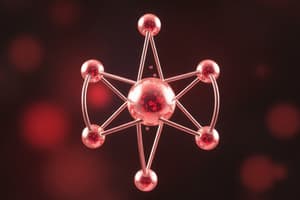Podcast
Questions and Answers
What is the charge of a proton?
What is the charge of a proton?
- Neutral
- Positive (correct)
- Negative
- Variable
Which of the following defines the atomic number of an element?
Which of the following defines the atomic number of an element?
- Number of neutrons
- Number of electrons
- Number of protons and neutrons
- Number of protons (correct)
What are atoms of the same element with different numbers of neutrons called?
What are atoms of the same element with different numbers of neutrons called?
- Molecules
- Allotropes
- Ions
- Isotopes (correct)
Which electrons are involved in chemical bonding?
Which electrons are involved in chemical bonding?
What type of bond involves the transfer of electrons between atoms?
What type of bond involves the transfer of electrons between atoms?
Which type of bond involves the sharing of electrons between atoms?
Which type of bond involves the sharing of electrons between atoms?
Which of the following is a strong intermolecular force that occurs between hydrogen and highly electronegative atoms?
Which of the following is a strong intermolecular force that occurs between hydrogen and highly electronegative atoms?
What are the starting materials in a chemical reaction called?
What are the starting materials in a chemical reaction called?
Which factor does NOT affect the rate of a chemical reaction?
Which factor does NOT affect the rate of a chemical reaction?
What is the role of a catalyst in a chemical reaction?
What is the role of a catalyst in a chemical reaction?
Which state of matter has a fixed shape and volume?
Which state of matter has a fixed shape and volume?
In the periodic table, elements in the same column have similar:
In the periodic table, elements in the same column have similar:
What is a homogeneous mixture of two or more substances called?
What is a homogeneous mixture of two or more substances called?
What is the substance that dissolves another substance in a solution?
What is the substance that dissolves another substance in a solution?
Acids release which type of ion when dissolved in water?
Acids release which type of ion when dissolved in water?
What is the pH of a neutral solution?
What is the pH of a neutral solution?
Flashcards
Atom
Atom
The fundamental building block of matter, consisting of a nucleus and electrons.
Proton
Proton
A positively charged particle found in the nucleus of an atom.
Atomic Number
Atomic Number
The number of protons in an atom's nucleus, defining the element.
Ionic Bonding
Ionic Bonding
Signup and view all the flashcards
Covalent Bonding
Covalent Bonding
Signup and view all the flashcards
Chemical Equation
Chemical Equation
Signup and view all the flashcards
Stoichiometry
Stoichiometry
Signup and view all the flashcards
Valence Electrons
Valence Electrons
Signup and view all the flashcards
Factors affecting reaction rates
Factors affecting reaction rates
Signup and view all the flashcards
States of Matter
States of Matter
Signup and view all the flashcards
Properties of Solids
Properties of Solids
Signup and view all the flashcards
Properties of Liquids
Properties of Liquids
Signup and view all the flashcards
Periodic Table arrangement
Periodic Table arrangement
Signup and view all the flashcards
Acids and Bases
Acids and Bases
Signup and view all the flashcards
Neutralization reactions
Neutralization reactions
Signup and view all the flashcards
Solubility
Solubility
Signup and view all the flashcards
Study Notes
Atomic Structure
- Atoms are the fundamental building blocks of matter.
- Atoms consist of a nucleus, containing protons and neutrons, surrounded by electrons.
- Protons have a positive charge, while electrons have a negative charge. Neutrons are electrically neutral.
- The number of protons in an atom's nucleus defines its atomic number and uniquely identifies the element.
- The number of protons plus neutrons determines the atom's mass number.
- Isotopes are atoms of the same element with the same number of protons but different numbers of neutrons.
- Electron shells or energy levels (orbitals) determine the arrangement of electrons around the nucleus. Each shell can hold a specific maximum number of electrons.
- Electrons in the outermost shell are called valence electrons. These electrons are involved in chemical bonding.
Chemical Bonding
- Chemical bonds are forces that hold atoms together in molecules or compounds.
- Ionic bonding occurs when one atom transfers electrons to another, forming ions with opposite charges that attract.
- Covalent bonding occurs when atoms share electrons to achieve a stable electron configuration.
- Metallic bonding involves the sharing of valence electrons among a lattice of metal atoms.
- Intermolecular forces are attractive forces between molecules. They include hydrogen bonding, dipole-dipole interactions, and London dispersion forces.
- Hydrogen bonding is a strong type of dipole-dipole interaction that occurs between molecules containing hydrogen bonded to highly electronegative atoms (oxygen, nitrogen, or fluorine).
- Dipole-dipole interactions occur between polar molecules.
- London dispersion forces are weak attractive forces that arise from temporary fluctuations in electron distribution. They occur in all molecules, even nonpolar ones.
Chemical Reactions
- Chemical reactions involve the rearrangement of atoms to form new substances.
- Reactants are the substances that undergo change, while products are the substances formed.
- Chemical equations represent chemical reactions using chemical formulas and coefficients to balance the number of atoms of each element on both sides of the equation.
- Chemical reactions can be classified into various categories, including synthesis, decomposition, single displacement, double displacement, and combustion reactions.
- Stoichiometry is the quantitative relationship between reactants and products in a chemical reaction. It involves calculations of quantities based on balanced chemical equations.
- Factors affecting reaction rates include temperature, concentration of reactants, surface area of reactants, and catalysts. Catalysts speed up reactions without being consumed.
States of Matter
- Matter exists in three primary states: solid, liquid, and gas.
- Solids have a fixed shape and volume due to strong intermolecular forces that hold particles in fixed positions.
- Liquids have a fixed volume but take the shape of their container due to weaker intermolecular forces, allowing particles to move past each other.
- Gases have neither a fixed shape nor a fixed volume, taking both the shape and volume of their container, due to very weak intermolecular forces and high kinetic energy.
Periodic Table
- The periodic table organizes elements based on their atomic number and properties.
- Elements in the same column (group) have similar chemical properties because they have the same number of valence electrons.
- Elements in the same row (period) have increasing numbers of electron shells.
- Metals are generally good conductors of heat and electricity, located on the left of the periodic table.
- Nonmetals are generally poor conductors of heat and electricity, located on the right side.
- Metalloids exhibit properties of both metals and nonmetals.
Solutions
- A solution is a homogeneous mixture of two or more substances.
- The solute is the substance being dissolved, and the solvent is the substance doing the dissolving.
- Solutions can be formed between various substances, and their properties can be affected by temperature.
- Concentration refers to the amount of solute dissolved in a given amount of solvent.
- Solubility is the maximum amount of solute that can dissolve in a solvent at a given temperature.
- Colligative properties of solutions depend on the concentration of solute particles but not on the identity of the solute.
Acids and Bases
- Acids are substances that release hydrogen ions (H+) when dissolved in water.
- Bases are substances that release hydroxide ions (OH-) when dissolved in water.
- The pH scale measures the acidity or basicity of a solution.
- Acids have a pH value below 7, and bases have a pH value above 7. Pure water has a pH of 7.
- Neutralization reactions occur when an acid and a base react to form a salt and water.
Studying That Suits You
Use AI to generate personalized quizzes and flashcards to suit your learning preferences.




